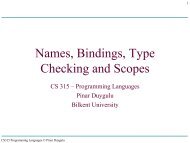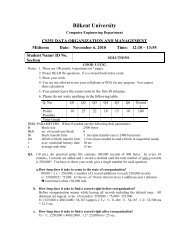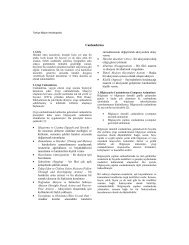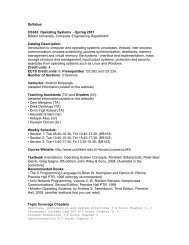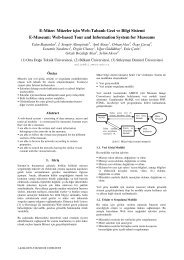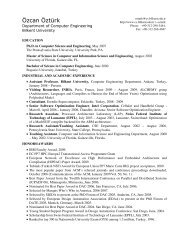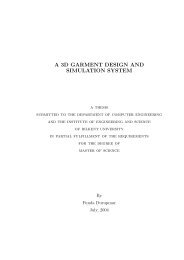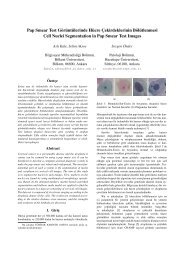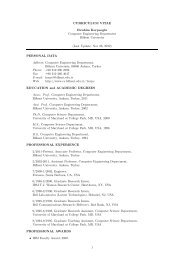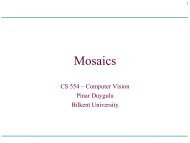On Probability of Success in Linear and ... - Bilkent University
On Probability of Success in Linear and ... - Bilkent University
On Probability of Success in Linear and ... - Bilkent University
Create successful ePaper yourself
Turn your PDF publications into a flip-book with our unique Google optimized e-Paper software.
<strong>On</strong> <strong>Probability</strong> <strong>of</strong> <strong>Success</strong> <strong>in</strong> L<strong>in</strong>ear <strong>and</strong><br />
Differential Cryptanalysis<br />
Ali Aydın Selçuk<br />
Department <strong>of</strong> Computer Eng<strong>in</strong>eer<strong>in</strong>g<br />
<strong>Bilkent</strong> <strong>University</strong><br />
Ankara, 06800, Turkey<br />
selcuk@cs.bilkent.edu.tr<br />
Abstract. Despite their widespread usage <strong>in</strong> block cipher security, l<strong>in</strong>ear<br />
<strong>and</strong> differential cryptanalysis still lack a robust treatment <strong>of</strong> their<br />
success probability, <strong>and</strong> the success chances <strong>of</strong> these attacks have commonly<br />
been estimated <strong>in</strong> a rather ad hoc fashion. In this paper, we present<br />
an analytical calculation <strong>of</strong> the success probability <strong>of</strong> l<strong>in</strong>ear <strong>and</strong> differential<br />
cryptanalytic attacks. The results apply to an extended sense <strong>of</strong><br />
the term “success” where the correct key is found not necessarily as the<br />
highest-rank<strong>in</strong>g c<strong>and</strong>idate but with<strong>in</strong> a set <strong>of</strong> high-rank<strong>in</strong>g c<strong>and</strong>idates.<br />
Experimental results show that the analysis provides accurate results<br />
<strong>in</strong> most cases, especially <strong>in</strong> l<strong>in</strong>ear cryptanalysis. In cases where the results<br />
are less accurate, as <strong>in</strong> certa<strong>in</strong> cases <strong>of</strong> differential cryptanalysis,<br />
the results are useful to provide approximate estimates <strong>of</strong> the success<br />
probability <strong>and</strong> the necessary pla<strong>in</strong>text requirement. The analysis also<br />
reveals that the attacked key length <strong>in</strong> differential cryptanalysis is one <strong>of</strong><br />
the factors that affect the success probability directly besides the signalto-noise<br />
ratio <strong>and</strong> the available pla<strong>in</strong>text amount.<br />
Key words. Block ciphers, l<strong>in</strong>ear cryptanalysis, differential cryptanalysis,<br />
success probability, order statistics.<br />
1 Introduction<br />
Differential cryptanalysis (DC) [3] <strong>and</strong> l<strong>in</strong>ear cryptanalysis (LC) [11, 12] are two<br />
<strong>of</strong> the most important techniques <strong>in</strong> block cipher cryptanalysis today. Virtually<br />
every modern block cipher has its security checked aga<strong>in</strong>st these attacks <strong>and</strong> a<br />
number <strong>of</strong> them have actually been broken. Despite this widespread utilization,<br />
evaluation <strong>of</strong> the success probability <strong>of</strong> these attacks is usually done <strong>in</strong> a rather<br />
ad hoc fashion: <strong>Success</strong> chances <strong>of</strong> differential attacks are typically evaluated<br />
accord<strong>in</strong>g to the empirical observations based on the “signal-to-noise ratio” [3].<br />
In the case <strong>of</strong> l<strong>in</strong>ear cryptanalysis, arbitrary ciphers are analyzed us<strong>in</strong>g Matsui’s<br />
results for his DES attacks [11, 12], which were <strong>in</strong> fact carefully calculated for<br />
<strong>and</strong> were specific to those particular attacks.<br />
In this paper, we present an analytical, generally applicable calculation <strong>of</strong> the<br />
success probability <strong>of</strong> l<strong>in</strong>ear <strong>and</strong> differential attacks. Throughout the analysis, a<br />
generalized def<strong>in</strong>ition <strong>of</strong> the term “success” is dealt with: If an attack on an m-bit
key gets the correct value ranked among the top r out <strong>of</strong> 2 m possible c<strong>and</strong>idates,<br />
we say the attack obta<strong>in</strong>ed an (m − lg r)-bit advantage over exhaustive search.<br />
The traditional, more strict def<strong>in</strong>ition <strong>of</strong> success, where the attack discovers the<br />
right key as the first c<strong>and</strong>idate, corresponds to obta<strong>in</strong><strong>in</strong>g an m-bit advantage<br />
over an m-bit key.<br />
The analysis presented provides formulas for direct calculation <strong>of</strong> the success<br />
probability <strong>of</strong> l<strong>in</strong>ear <strong>and</strong> differential attacks. The amount <strong>of</strong> data required<br />
for an attack to achieve a certa<strong>in</strong> success probability can also be calculated<br />
through these formulas. Furthermore, the analysis shows that the aimed advantage<br />
level—that is, <strong>in</strong> more traditional terms, the number <strong>of</strong> key bits attacked—is<br />
one <strong>of</strong> the factors that affect the success probability <strong>in</strong> differential cryptanalysis<br />
directly besides the already established factors <strong>of</strong> the signal-to-noise ratio <strong>and</strong><br />
the expected number <strong>of</strong> right pairs.<br />
The notations <strong>in</strong> the paper common to all sections <strong>in</strong>clude φ <strong>and</strong> Φ for the<br />
probability density <strong>and</strong> the cumulative distribution functions <strong>of</strong> the st<strong>and</strong>ard<br />
normal distribution. Besides, B, N , <strong>and</strong> P are used for denot<strong>in</strong>g the b<strong>in</strong>omial,<br />
normal, <strong>and</strong> Poisson distributions, respectively.<br />
2 <strong>Success</strong> <strong>Probability</strong> <strong>in</strong> L<strong>in</strong>ear Cryptanalysis<br />
L<strong>in</strong>ear cryptanalysis, developed by Matsui[11], is a known-pla<strong>in</strong>text attack that<br />
exploits the statistical correlation among the pla<strong>in</strong>text, ciphertext, <strong>and</strong> key bits<br />
<strong>of</strong> a block cipher to discover the encryption key. The first step <strong>in</strong> a l<strong>in</strong>ear attack is<br />
to f<strong>in</strong>d a l<strong>in</strong>ear approximation for the cipher. A l<strong>in</strong>ear approximation is a b<strong>in</strong>ary<br />
equation <strong>of</strong> the bits <strong>of</strong> the pla<strong>in</strong>text, ciphertext, <strong>and</strong> the key, which holds with<br />
a probability p �= 1/2. The quantity |p − 1/2|, known as the bias, is a measure<br />
<strong>of</strong> correlation among the pla<strong>in</strong>text, ciphertext, <strong>and</strong> key bits, <strong>and</strong> it can be used<br />
to dist<strong>in</strong>guish the actual key from r<strong>and</strong>om key values. In an attack, the attacker<br />
collects a large number <strong>of</strong> pla<strong>in</strong>text-ciphertext blocks, <strong>and</strong> for each possible key<br />
value he counts the number <strong>of</strong> pla<strong>in</strong>text-ciphertext blocks that satisfy the approximation.<br />
Assum<strong>in</strong>g that the bias <strong>of</strong> the approximation with the right key<br />
will be significantly higher than the bias with a r<strong>and</strong>om key, the key value that<br />
maximizes the bias over the given pla<strong>in</strong>text sample is taken as the right key.<br />
In general, it may be sufficient to have the right key ranked reasonably high<br />
among the c<strong>and</strong>idates rather than hav<strong>in</strong>g it as the absolute highest. For example,<br />
<strong>in</strong> Matsui’s attack on DES, a 26-bit portion <strong>of</strong> the key was attacked where the<br />
right key was ranked among the top 2 13 . In this k<strong>in</strong>d <strong>of</strong> rank<strong>in</strong>g attacks, all<br />
c<strong>and</strong>idates ranked higher than the right key must be tried before the right key<br />
can be reached. Each c<strong>and</strong>idate must be checked with all comb<strong>in</strong>ations <strong>of</strong> the<br />
rema<strong>in</strong><strong>in</strong>g, unattacked bits to see if it is the right value. In such an attack,<br />
where an m-bit key is attacked <strong>and</strong> the right key is ranked rth among all 2 m<br />
c<strong>and</strong>idates, the attack provides a complexity reduction by a factor <strong>of</strong> 2<br />
m−lg r<br />
over the exhaustive search. In our analysis, we refer to m − lg r as the advantage<br />
provided by the attack.<br />
2
2.1 Problem Statement<br />
Consider the problem where an attacker is <strong>in</strong>terested <strong>in</strong> gett<strong>in</strong>g the right key<br />
ranked with<strong>in</strong> the r top c<strong>and</strong>idates among a total <strong>of</strong> 2 m keys, where an mbit<br />
key is attacked, with an approximation <strong>of</strong> probability p, us<strong>in</strong>g N pla<strong>in</strong>text<br />
blocks. Let k0 denote the right key <strong>and</strong> ki, 1 ≤ i ≤ 2 m − 1, be the wrong key<br />
values, <strong>and</strong> let n denote 2 m − 1. Let Xi = Ti/N − 1/2 <strong>and</strong> Yi = |Xi|, where Ti<br />
is the counter for the pla<strong>in</strong>texts satisfy<strong>in</strong>g the approximation with key ki. Let<br />
Wi, 1 ≤ i ≤ 2 m − 1, be the Yi, i �= 0, sorted <strong>in</strong> <strong>in</strong>creas<strong>in</strong>g order. That is, W1 is<br />
the lowest sample bias |Ti/N − 1/2| obta<strong>in</strong>ed among the wrong keys, Wn is the<br />
highest. Then, the two conditions for the success <strong>of</strong> the attack are<br />
X0/(p − 1/2) > 0, (1)<br />
that is, T0/N − 1/2 <strong>and</strong> p − 1/2 have the same sign, <strong>and</strong><br />
|X0| > Wn−r+1. (2)<br />
In the rest <strong>of</strong> this analysis, we assume for simplicity that p > 1/2. 1 Hence, the<br />
two conditions become<br />
X0 > 0, (3)<br />
X0 > Wn−r+1. (4)<br />
This model<strong>in</strong>g <strong>of</strong> the success probability was orig<strong>in</strong>ally given by Junod [7],<br />
where he derived an expression <strong>of</strong> the success probability <strong>in</strong> terms <strong>of</strong> Euler’s<br />
<strong>in</strong>complete beta <strong>in</strong>tegral assum<strong>in</strong>g that the Tis are <strong>in</strong>dependent <strong>and</strong> they are<br />
identically distributed for i �= 0. He also presented a numerical calculation <strong>of</strong> that<br />
expression for Matsui’s 26-bit DES attack [12] assum<strong>in</strong>g that the approximation<br />
has a zero bias for a wrong key, i.e., E[Ti/N − 1/2] = 0 for i �= 0.<br />
Here, we present a more general calculation <strong>of</strong> the success probability us<strong>in</strong>g<br />
the normal approximation for order statistics. Like Junod, we also assume the<br />
<strong>in</strong>dependence <strong>of</strong> the Ti counters <strong>and</strong> a zero bias for the wrong keys. S<strong>in</strong>ce the<br />
zero bias for the wrong keys is the ideal case for an attacker, the results can be<br />
seen as an upper bound for the actual success probability.<br />
2.2 Order Statistics<br />
In this section we give a brief review <strong>of</strong> order statistics, as treated <strong>in</strong> [13]. Theorem<br />
1, the key for our analysis, states the normal approximation for the order<br />
statistics.<br />
Def<strong>in</strong>ition 1. Let ξ1, ξ2, . . . , ξn be <strong>in</strong>dependent, identically distributed r<strong>and</strong>om<br />
variables. Arrange the values <strong>of</strong> ξ1, ξ2, . . . , ξn <strong>in</strong> <strong>in</strong>creas<strong>in</strong>g order, result<strong>in</strong>g <strong>in</strong><br />
ξ ∗ 1, ξ ∗ 2, . . . , ξ ∗ n. The statistic ξ ∗ i is called the i-th order statistic <strong>of</strong> the sample<br />
1 The correspond<strong>in</strong>g results for the case p < 1/2 can easily be obta<strong>in</strong>ed by substitut<strong>in</strong>g<br />
−X0 for X0.<br />
3
ξ1, ξ2, . . . , ξn.<br />
Def<strong>in</strong>ition 2. For 0 < q < 1, the sample quantile <strong>of</strong> order q is the ⌊qn⌋ + 1-th<br />
order statistic ξ ∗ ⌊qn⌋+1 .<br />
Theorem 1. Let ξ1, ξ2, . . . , ξn be <strong>in</strong>dependent, identically distributed r<strong>and</strong>om<br />
variables, with an absolutely cont<strong>in</strong>uous distribution function F (x). Suppose that<br />
the density function f(x) = F ′ (x) is cont<strong>in</strong>uous <strong>and</strong> positive on the <strong>in</strong>terval<br />
[a, b). If 0 < F (a) < q < F (b) < 1, <strong>and</strong> if i(n) is a sequence <strong>of</strong> <strong>in</strong>tegers such that<br />
�<br />
√ �<br />
lim n �<br />
i(n)<br />
n→∞ � n<br />
�<br />
�<br />
− q�<br />
� = 0,<br />
further if ξ ∗ i denotes i-th order statistic <strong>of</strong> the sample ξ1, ξ2, . . . , ξn, then ξ ∗ i(n) is<br />
<strong>in</strong> the limit normally distributed, i.e.,<br />
where<br />
lim<br />
n→∞ P<br />
� ∗ ξi(n) − µq<br />
σq<br />
�<br />
< x = Φ(x),<br />
µq = F −1 (q),<br />
σq = 1<br />
�<br />
q(1 − q)<br />
.<br />
f(µq) n<br />
Tak<strong>in</strong>g i(n) = ⌊qn⌋ + 1, the theorem states that the empirical sample quantile<br />
<strong>of</strong> order q <strong>of</strong> a sample <strong>of</strong> n elements is for sufficiently large n nearly nor-<br />
mally distributed with expectation µq = F −1 (q) <strong>and</strong> st<strong>and</strong>ard deviation σq =<br />
1<br />
f(µq)<br />
�<br />
q(1−q)<br />
n .<br />
2.3 <strong>Success</strong> <strong>Probability</strong><br />
The sample bias <strong>of</strong> the right key, X0 = T0/N − 1/2, approximately follows<br />
a normal distribution N (µ0, σ 2 0) with µ0 = p − 1/2 <strong>and</strong> σ 2 0 = 1/(4N). The<br />
absolute sample bias <strong>of</strong> wrong keys, Yi, i �= 0, follow a folded normal distribution<br />
(see Appendix A) FN (µw, σ 2 w) with µw = 0, assum<strong>in</strong>g a zero bias for wrong keys,<br />
<strong>and</strong> σ 2 w = 1/(4N). We use f0, F0 <strong>and</strong> fw, Fw to denote the probability density<br />
<strong>and</strong> the cumulative distribution functions <strong>of</strong> X0 <strong>and</strong> Yi, i �= 0, respectively.<br />
In an a-bit advantage attack on an m-bit key, success is def<strong>in</strong>ed as<br />
X0 > 0 (5)<br />
X0 > W¯r<br />
where W1, W2, . . . , W2 m −1 are the absolute sample bias <strong>of</strong> the wrong keys sorted<br />
<strong>in</strong> <strong>in</strong>creas<strong>in</strong>g order, <strong>and</strong> ¯r denotes 2 m − 2 m−a . Accord<strong>in</strong>g to Theorem 1, W¯r<br />
4<br />
(6)
approximately follows a normal distribution N (µq, σ 2 q), which we denote by Fq,<br />
where<br />
µq = F −1<br />
w (1 − 2 −a ) = µw + σwΦ −1 (1 − 2 −a−1 )<br />
σq =<br />
1<br />
m+a<br />
2− 2 =<br />
fw(µq)<br />
σw<br />
2φ(Φ−1 (1 − 2−a−1 m+a<br />
2− 2 ,<br />
))<br />
s<strong>in</strong>ce Fw is folded normal. Then the probability <strong>of</strong> success, PS, is<br />
PS =<br />
� ∞ � x<br />
0<br />
−∞<br />
fq(y) dy f0(x) dx . (7)<br />
For a, m ≥ 8, we have µq > 5σq <strong>and</strong>, therefore, the probability <strong>of</strong> W¯r < 0 is<br />
negligible. Hence, (5) <strong>and</strong> (6) can be comb<strong>in</strong>ed as<br />
X0 > W¯r. (8)<br />
S<strong>in</strong>ce both X0 <strong>and</strong> W¯r follow a normal distribution, X0 − W¯r follows a normal<br />
distribution too, which we denote by FJ, with mean µ0−µq <strong>and</strong> variance σ 2 0 +σ 2 q.<br />
Therefore,<br />
PS = P (X0 − W¯r > 0)<br />
=<br />
=<br />
� ∞<br />
0<br />
� ∞<br />
fJ(x) dx<br />
− µ 0−µq √<br />
σ2 0<br />
+σ2 q<br />
φ(x) dx . (9)<br />
Table 1 gives a numeric calculation <strong>of</strong> (9) for certa<strong>in</strong> values <strong>of</strong> a <strong>and</strong> m, with<br />
N = 8|p − 1/2| −2 pla<strong>in</strong>text blocks.<br />
a m = 8 m = 16 m = 32 m = 48<br />
8 0.996 0.997 0.997 0.997<br />
16 — 0.903 0.909 0.909<br />
32 — — 0.250 0.248<br />
48 — — — 0.014<br />
Table 1. The success probability PS accord<strong>in</strong>g to equation (9) for obta<strong>in</strong><strong>in</strong>g an a-bit<br />
advantage on an m-bit key, for N = 8|p − 1/2| −2 pla<strong>in</strong>texts.<br />
In Table 1, it is <strong>in</strong>terest<strong>in</strong>g that PS is almost <strong>in</strong>dependent <strong>of</strong> the key length<br />
m for a given a. Note that, for 8 ≤ a ≤ 48, σq satisfies 10 −6 ≤ σq/σ0 ≤ 10 −1 .<br />
Especially when deal<strong>in</strong>g with success probabilities <strong>of</strong> 80% or more, the effect <strong>of</strong><br />
5
�<br />
σq is negligible <strong>and</strong> we can assume σ2 0 + σ2 q ≈ σ0. Then (9) becomes<br />
PS =<br />
=<br />
� ∞<br />
− µ 0−µq σ0 � ∞<br />
φ(x) dx (10)<br />
−2 √ N(|p−1/2|−F −1<br />
w (1−2 −a ))<br />
φ(x) dx , (11)<br />
where the success probability is a function <strong>of</strong> the advantage level a, <strong>in</strong>dependent<br />
<strong>of</strong> the number <strong>of</strong> key bits attacked m.<br />
In (11), Fw is the folded normal distribution FN (0, σ 2 w), <strong>and</strong> F −1<br />
w (1−2 −a ) =<br />
σwΦ −1 (1 − 2 −a−1 ) for σw = 1/(2 √ N), yield<strong>in</strong>g the follow<strong>in</strong>g ma<strong>in</strong> result:<br />
Theorem 2. Let PS be the probability that a l<strong>in</strong>ear attack on an m-bit subkey,<br />
with a l<strong>in</strong>ear approximation <strong>of</strong> probability p, with N known pla<strong>in</strong>text blocks,<br />
delivers an a-bit or higher advantage. Assum<strong>in</strong>g that the l<strong>in</strong>ear approximation’s<br />
probability to hold is <strong>in</strong>dependent for each key tried <strong>and</strong> is equal to 1/2 for all<br />
wrong keys, we have, for sufficiently large m <strong>and</strong> N,<br />
PS = Φ<br />
�<br />
2 √ N|p − 1/2| − Φ −1 (1 − 2 −a−1 �<br />
)<br />
. (12)<br />
A numerical calculation <strong>of</strong> (12) is shown <strong>in</strong> Table 2, where the success probability<br />
is given as a function <strong>of</strong> the aimed advantage level a <strong>and</strong> cN , the amount<br />
<strong>of</strong> available pla<strong>in</strong>texts as a multiple <strong>of</strong> |p − 1/2| −2 (i.e., cN = N/|p − 1/2| −2 ). A<br />
comparison <strong>of</strong> the columns <strong>of</strong> Table 1 to the column <strong>of</strong> Table 2 for cN = 8 shows<br />
that the two are almost identical.<br />
a cN = 2 cN = 4 cN = 8 cN = 16 cN = 32 cN = 64<br />
8 0.477 0.867 0.997 1.000 1.000 1.000<br />
16 0.067 0.373 0.909 1.000 1.000 1.000<br />
32 0.000 0.010 0.248 0.952 1.000 1.000<br />
48 0.000 0.000 0.014 0.552 0.999 1.000<br />
Table 2. <strong>Probability</strong> <strong>of</strong> achiev<strong>in</strong>g an a-bit advantage with N = cN |p − 1/2| −2 pla<strong>in</strong>texts,<br />
accord<strong>in</strong>g to equation (12).<br />
Equation (12) implies that 2 √ N|p − 1/2| − Φ −1 (1 − 2 −a−1 ) = Φ −1 (PS),<br />
yield<strong>in</strong>g a direct formula to calculate the required number <strong>of</strong> pla<strong>in</strong>texts to achieve<br />
a certa<strong>in</strong> success probability PS:<br />
Corollary 1. With the assumptions <strong>of</strong> Theorem 2,<br />
� −1 Φ (PS) + Φ<br />
N =<br />
−1 (1 − 2−a−1 )<br />
2<br />
�2<br />
· |p − 1/2| −2<br />
pla<strong>in</strong>text blocks are needed <strong>in</strong> a l<strong>in</strong>ear attack to accomplish an a-bit advantage<br />
with a success probability <strong>of</strong> PS.<br />
6<br />
(13)
2.4 Discussion <strong>of</strong> the Assumptions <strong>and</strong> Experimental Results<br />
In a typical l<strong>in</strong>ear attack, N is at least <strong>in</strong> the order <strong>of</strong> 2 20 <strong>and</strong> p is very close<br />
to 1/2. Hence, the normal approximation for the b<strong>in</strong>omial Ti counters <strong>and</strong> for<br />
Xi = (Ti/N − 1/2) can be expected to be extremely good.<br />
Regard<strong>in</strong>g the normal approximation for the order statistics, the sample size<br />
is n = 2 m −1, which can be expected to give accurate results for fairly large values<br />
<strong>of</strong> m [16]. For a practical evaluation, we implemented Matsui’s 8-round DES<br />
attack [12] <strong>and</strong> compared the actual success probability to the results <strong>of</strong> (12).<br />
The attack uses a 6-round DES approximation with a bias 1.95 · 2 −9 <strong>and</strong> targets<br />
the keys <strong>of</strong> S5 <strong>in</strong> the first <strong>and</strong> the eighth rounds, with 12 key bits <strong>in</strong> total. 2 In<br />
the experiments the attack was run 10,000 times for each value <strong>of</strong> N.<br />
The success probability accord<strong>in</strong>g to the experimental results <strong>and</strong> accord<strong>in</strong>g<br />
to equation (12) are compared <strong>in</strong> Figure 1. Figure 1(a) shows that (12) gives a<br />
quite precise calculation <strong>of</strong> the success probability for most cases. The exception<br />
to this accuracy, as Figure 1(b) shows, is when the top rank<strong>in</strong>g probability is <strong>of</strong><br />
concern <strong>and</strong> with a relatively small PS value, <strong>in</strong> which case about a 10% error<br />
rate is possible.<br />
2.5 <strong>Probability</strong> <strong>of</strong> Top Rank<strong>in</strong>g<br />
A more precise calculation <strong>of</strong> the success probability is possible for the special<br />
case a = m (i.e., when the right key is to be ranked the highest) which does<br />
not use the normal approximation for order statistics. In this case, the success<br />
probability can be expressed directly as<br />
PS =<br />
=<br />
� ∞ �� x<br />
0<br />
� ∞<br />
−2 √ N|p−1/2|<br />
fw(y) dy<br />
−x<br />
� 2 m −1<br />
f0(x) dx<br />
� � x+2 √ N|p−1/2|<br />
−x−2 √ φ(y)dy<br />
N|p−1/2|<br />
� 2 m −1<br />
φ(x)dx , (14)<br />
aga<strong>in</strong> assum<strong>in</strong>g that the Ti counters are <strong>in</strong>dependent. A numerical comparison<br />
<strong>of</strong> (12), (14), <strong>and</strong> the experimental results is given <strong>in</strong> Table 3.<br />
3 <strong>Success</strong> <strong>Probability</strong> <strong>in</strong> Differential Cryptanalysis<br />
Differential cryptanalysis, developed by Biham <strong>and</strong> Shamir [3], is a chosenpla<strong>in</strong>text<br />
attack that exploits the correlation between the <strong>in</strong>put <strong>and</strong> output differences<br />
<strong>of</strong> a pair <strong>of</strong> pla<strong>in</strong>text blocks encrypted under the same key. The first<br />
2 The benefit <strong>of</strong> us<strong>in</strong>g DES <strong>in</strong> this experiment is that, it was observed <strong>in</strong> [15] that<br />
the bias <strong>of</strong> l<strong>in</strong>ear approximations <strong>of</strong> DES-like ciphers can be estimated accurately by<br />
the pil<strong>in</strong>g-up lemma [11], which is not always the case for other ciphers (e.g., RC5).<br />
Hence, us<strong>in</strong>g DES as the test cipher, the experiments can be conducted free <strong>of</strong> the<br />
errors that would result from a miscalculation <strong>of</strong> the bias.<br />
7
P(rank(k 0 ) ≤ r)<br />
1<br />
N = 219<br />
0.8<br />
0.6<br />
0.4<br />
0.2<br />
N = 2 18<br />
N = 2 17<br />
N = 2 16<br />
0<br />
0 100 200 300 400 500<br />
r<br />
600 700 800 900 1000<br />
N = 2 20<br />
(a) The results for the range 1 ≤ rank(k0) ≤ 1000. The theoretical <strong>and</strong><br />
experimental results are mostly <strong>in</strong>dist<strong>in</strong>guishable.<br />
P(rank(k 0 ) ≤ r)<br />
1<br />
0.8<br />
0.6<br />
0.4<br />
0.2<br />
N = 2 19<br />
N = 2 18<br />
N = 2 17<br />
N = 2 16<br />
0<br />
1 2 3 4 5 6 7 8 9 10<br />
r<br />
N = 2 20<br />
(b) The same plots with a focus on the range 1–10. Now a difference can<br />
be observed, especially when the top rank<strong>in</strong>g probability is <strong>of</strong> concern. The<br />
theoretical <strong>and</strong> practical results are still <strong>in</strong>dist<strong>in</strong>guishable for N = 2 20 .<br />
Fig. 1. A comparison <strong>of</strong> equation (12) with the experimental success rates. The bias<br />
<strong>of</strong> the l<strong>in</strong>ear approximation is 1.95 · 2 −9 . The plots with the l<strong>in</strong>espo<strong>in</strong>t style show the<br />
experimental results; those with the l<strong>in</strong>es style are PS accord<strong>in</strong>g to equation (12).<br />
step <strong>in</strong> a differential attack is to f<strong>in</strong>d a characteristic <strong>of</strong> the cipher attacked. A<br />
characteristic is a sequence <strong>of</strong> differences between the round <strong>in</strong>puts <strong>in</strong> the encryption<br />
<strong>of</strong> two pla<strong>in</strong>text blocks with a given <strong>in</strong>itial difference. For a characteristic<br />
8
N (12) (14) Exp.<br />
2 16 0.043 0.038 0.033<br />
2 17 0.181 0.159 0.151<br />
2 18 0.592 0.539 0.509<br />
2 19 0.968 0.949 0.930<br />
2 20 0.999 0.999 0.999<br />
Table 3. The top rank<strong>in</strong>g probability P (rank(k0) = 1) <strong>in</strong> LC accord<strong>in</strong>g to (12), (14),<br />
<strong>and</strong> the experimental results.<br />
to be useful <strong>in</strong> an attack, a pla<strong>in</strong>text pair with the given <strong>in</strong>itial difference must<br />
have a non-trivial probability to follow the given sequence <strong>of</strong> differences dur<strong>in</strong>g<br />
encryption. Hav<strong>in</strong>g obta<strong>in</strong>ed such a characteristic, the attacker collects a large<br />
number <strong>of</strong> pla<strong>in</strong>text-ciphertext pairs with the given <strong>in</strong>itial difference. Assum<strong>in</strong>g<br />
that the characteristic is followed at the <strong>in</strong>ner rounds <strong>of</strong> the cipher, each pair<br />
will suggest a set <strong>of</strong> c<strong>and</strong>idates for the last round key. When a pair is a “right<br />
pair”, which followed the characteristic, the actual key will always be among<br />
the keys suggested. If the pair is “wrong”, it may be detected <strong>and</strong> discarded,<br />
or, otherwise, it will suggest a set <strong>of</strong> r<strong>and</strong>om keys. After process<strong>in</strong>g all collected<br />
pairs <strong>and</strong> count<strong>in</strong>g the keys they suggest, the key value that is suggested most<br />
will be taken as the right key.<br />
An important measure for the success <strong>of</strong> a differential attack is the proportion<br />
<strong>of</strong> the probability <strong>of</strong> the right key be<strong>in</strong>g suggested by a right pair to the<br />
probability <strong>of</strong> a r<strong>and</strong>om key be<strong>in</strong>g suggested by a r<strong>and</strong>om pair with the given<br />
<strong>in</strong>itial difference. This proportion is called the “signal-to-noise ratio”. Biham <strong>and</strong><br />
Shamir [3] observed a strong relation between the signal-to-noise ratio <strong>and</strong> the<br />
success chance <strong>of</strong> an attack. By empirical evidence, they suggested that when the<br />
signal-to-noise ratio is around 1–2, about 20–40 right pairs would be sufficient;<br />
<strong>and</strong> when the signal-to-noise ratio is much higher, 3–4 right pairs would usually<br />
be enough.<br />
3.1 Distribution Parameters<br />
We use a notation similar to the one used for l<strong>in</strong>ear cryptanalysis: m is the<br />
number <strong>of</strong> key bits attacked; N denotes the total number <strong>of</strong> pairs analyzed.<br />
k0 denotes the right key, ki, 1 ≤ i ≤ 2 m − 1, denote the wrong keys. pi is the<br />
probability <strong>of</strong> ki be<strong>in</strong>g suggested by a pla<strong>in</strong>text pair; Ti counts the number <strong>of</strong><br />
times ki is suggested. Wi, 1 ≤ i ≤ 2 m − 1, denote Ti, i �= 0, sorted <strong>in</strong> <strong>in</strong>creas<strong>in</strong>g<br />
order. The probability <strong>of</strong> the characteristic is denoted by p, <strong>and</strong> µ = pN denotes<br />
the expected number <strong>of</strong> right pairs. pr is the average probability <strong>of</strong> some given key<br />
be<strong>in</strong>g suggested by a r<strong>and</strong>om pair with the given <strong>in</strong>itial difference. SN denotes<br />
the signal-to-noise ratio, p/pr.<br />
In our analysis, we assume that the Ti values are <strong>in</strong>dependent <strong>and</strong> that they<br />
are identically distributed for i �= 0. The latter assumption means that all wrong<br />
9
keys have the same chance <strong>of</strong> be<strong>in</strong>g suggested by a r<strong>and</strong>om pair. That is, all<br />
pi, i �= 0, are identical. We denote this probability by pw.<br />
The Ti counters have a b<strong>in</strong>omial distribution, B(N, p0) for T0 <strong>and</strong> B(N, pw)<br />
for Ti, i �= 0. We denote these distribution functions by F0 <strong>and</strong> Fw, <strong>and</strong> their<br />
density functions by f0 <strong>and</strong> fw, respectively. Typically, N is very large <strong>and</strong> therefore<br />
these b<strong>in</strong>omial distributions can be approximated by normal distributions,<br />
N (µ0, σ 2 0) <strong>and</strong> N (µw, σ 2 w), where the distribution parameters are,<br />
µ0 = p0N, σ 2 0 = p0(1 − p0)N ≈ p0N,<br />
µw = pwN, σ 2 w = pw(1 − pw)N ≈ pwN.<br />
In a typical differential attack, the right key gets counted by right pairs <strong>and</strong><br />
also gets r<strong>and</strong>om hits from wrong pairs, while the wrong keys only gets hits from<br />
wrong pairs. In this case, we have<br />
p0 = p + (1 − p)pr ≈ p + pr,<br />
pw = pr.<br />
Note that this typical behavior does not always happen <strong>and</strong> <strong>in</strong> certa<strong>in</strong> exceptional<br />
cases (e.g., [5]) the right key gets counted only by right pairs without gett<strong>in</strong>g any<br />
r<strong>and</strong>om hits from wrong pairs. In such attacks, we have p0 = p. The follow<strong>in</strong>g<br />
analysis assumes the more typical case where p0 = p + pr but can easily be<br />
extended to cases where p0 = p by substitut<strong>in</strong>g p for p0 <strong>in</strong> equation (17) <strong>and</strong><br />
do<strong>in</strong>g the follow<strong>in</strong>g derivations accord<strong>in</strong>gly.<br />
3.2 <strong>Success</strong> <strong>Probability</strong><br />
In an a-bit advantage attack, success is def<strong>in</strong>ed by gett<strong>in</strong>g k0 ranked with<strong>in</strong> the<br />
top 2 m−a c<strong>and</strong>idates; that is, T0 > W 2 m −2 m−a. We denote 2 m − 2 m−a by ¯r.<br />
An analysis along the same l<strong>in</strong>es as the one on l<strong>in</strong>ear cryptanalysis—with the<br />
only major difference be<strong>in</strong>g that the Tis here have a normal distribution whereas<br />
the Yis <strong>in</strong> l<strong>in</strong>ear cryptanalysis had a folded normal—gives<br />
PS =<br />
� ∞<br />
− µ 0−µq √<br />
σ2 0<br />
+σ2 q<br />
where µq = µw + σwΦ −1 (1 − 2 −a ), σq =<br />
have<br />
PS =<br />
� ∞<br />
− µ 0 −µq<br />
σ 0<br />
10<br />
φ(x) dx , (15)<br />
σw<br />
φ(Φ−1 (1−2−a m+a<br />
))<br />
2− 2 . For σ2 q ≪ σ2 0, we<br />
φ(x) dx . (16)
The lower bound <strong>of</strong> the <strong>in</strong>tegral can be written <strong>in</strong> terms <strong>of</strong> the signal-to-noise<br />
ratio as,<br />
−µ0 + µq<br />
σ0<br />
= −p0N + pwN + √ pwNΦ −1 (1 − 2 −a )<br />
√ p0N<br />
= −pN + √ prNΦ −1 (1 − 2 −a )<br />
� (p + pr)N<br />
= − � �<br />
p<br />
pN<br />
p + pr<br />
= − √ µ<br />
� SN<br />
�<br />
pr<br />
+<br />
Φ −1 (1 − 2 −a )<br />
(17)<br />
p + pr<br />
SN + 1 +<br />
�<br />
1<br />
SN + 1 Φ−1 (1 − 2 −a ) . (18)<br />
Hence, the follow<strong>in</strong>g result is obta<strong>in</strong>ed for the success probability:<br />
Theorem 3. Let PS be the probability that a differential attack on an m-bit key,<br />
with a characteristic <strong>of</strong> probability p <strong>and</strong> signal-to-noise ratio SN , <strong>and</strong> with N<br />
pla<strong>in</strong>text-ciphertext pairs, delivers an a-bit or higher advantage. Assum<strong>in</strong>g that<br />
the key counters are <strong>in</strong>dependent <strong>and</strong> that they are identically distributed for all<br />
wrong keys, we have, for sufficiently large m <strong>and</strong> N, <strong>and</strong> µ denot<strong>in</strong>g pN,<br />
PS = Φ<br />
�√<br />
µ SN − Φ−1 (1 − 2−a �<br />
)<br />
√ . (19)<br />
SN + 1<br />
A numerical calculation <strong>of</strong> (19) for SN = 1 <strong>and</strong> SN = 1000 is given <strong>in</strong><br />
Table 4 to provide a comparison with Biham <strong>and</strong> Shamir’s empirical results [3].<br />
The values very much agree with their observations for large SN . For small SN ,<br />
the suggested 20–40 right pairs give a good success rate only for a < 20. To have<br />
a good success rate for larger values <strong>of</strong> a as well, 80 or more right pairs may be<br />
needed.<br />
Note that <strong>in</strong> (19), when SN is very large, �√ µ SN − Φ −1 (1 − 2 −a ) � / √ SN + 1 ≈<br />
√ µ <strong>and</strong> PS ≈ Φ( √ µ). Hence, for large SN , we can talk about the success probability<br />
as a function <strong>of</strong> µ only, <strong>in</strong>dependent <strong>of</strong> a, as it was discussed by Biham<br />
<strong>and</strong> Shamir [3].<br />
As <strong>in</strong> l<strong>in</strong>ear cryptanalysis, we can use (19) to get a direct formulation <strong>of</strong><br />
the required number <strong>of</strong> pla<strong>in</strong>text-ciphertext pairs to achieve a certa<strong>in</strong> success<br />
probability PS:<br />
Corollary 2. With the assumptions <strong>of</strong> Theorem 3,<br />
N =<br />
�√<br />
SN + 1Φ−1 (PS) + Φ−1 (1 − 2−a ) �2 p −1<br />
SN<br />
pla<strong>in</strong>text-ciphertext pairs are needed <strong>in</strong> a differential attack to accomplish an<br />
a-bit advantage with a success probability <strong>of</strong> PS.<br />
11<br />
(20)
a µ = 20 µ = 40 µ = 60 µ = 80 µ = 100 µ = 120<br />
8 0.900 0.995 1.000 1.000 1.000 1.000<br />
16 0.585 0.936 0.994 1.000 1.000 1.000<br />
32 0.107 0.527 0.858 0.973 0.996 1.000<br />
48 0.010 0.151 0.490 0.794 0.942 0.988<br />
(a) SN = 1<br />
a µ = 4 µ = 5 µ = 6 µ = 7 µ = 8 µ = 9<br />
8 0.972 0.984 0.991 0.995 0.997 0.998<br />
16 0.969 0.982 0.990 0.994 0.997 0.998<br />
32 0.964 0.979 0.988 0.993 0.996 0.998<br />
48 0.960 0.977 0.986 0.992 0.995 0.997<br />
(b) SN = 1000<br />
Table 4. <strong>Probability</strong> <strong>of</strong> achiev<strong>in</strong>g an a-bit advantage for various values <strong>of</strong> the expected<br />
number <strong>of</strong> right pairs µ, accord<strong>in</strong>g to equation (19).<br />
3.2.1 Alternative Models<br />
It can reasonably be said that the normal approximation for the b<strong>in</strong>omial counters<br />
may not be accurate when Np(1 − p) < 4; hence alternative distributions<br />
should be considered <strong>in</strong> the attacks where SN is high <strong>and</strong> the number <strong>of</strong> rights<br />
pairs is accord<strong>in</strong>gly low. For such attacks, Poisson approximations P(µ0) <strong>and</strong><br />
P(µw) or the orig<strong>in</strong>al b<strong>in</strong>omial distributions B(N, p0) <strong>and</strong> B(N, pw) can be preferred<br />
to model the counters.<br />
Although more accurate results are possible by the Poisson or b<strong>in</strong>omial distributions,<br />
these distributions lack the ma<strong>in</strong> advantage <strong>of</strong> us<strong>in</strong>g the normal distribution,<br />
which is to provide closed form expressions such as (19) <strong>and</strong> (20).<br />
Besides, as the results <strong>in</strong> Section 3.4 show, there does not appear to be a significant<br />
difference between the results obta<strong>in</strong>ed by the normal approximation <strong>and</strong><br />
those obta<strong>in</strong>ed by the orig<strong>in</strong>al b<strong>in</strong>omial distribution, even for smaller values <strong>of</strong><br />
µ0. Hence, the normal approximation appears to be mostly satisfactory. The experimental<br />
results po<strong>in</strong>t out a different, more <strong>in</strong>herent limitation however, which<br />
is discussed <strong>in</strong> Section 3.4.<br />
3.3 <strong>Probability</strong> <strong>of</strong> Top Rank<strong>in</strong>g<br />
Similar to that <strong>in</strong> LC, a more precise, direct calculation <strong>of</strong> the success probability<br />
<strong>of</strong> a differential attack is possible for the special case a = m (i.e., when the right<br />
key is to be ranked the highest) which does not use the normal approximation<br />
12
for order statistics:<br />
PS(m) =<br />
=<br />
� ∞<br />
−∞<br />
� ∞<br />
−∞<br />
�� x<br />
� 2 m −1<br />
fw(y) dy<br />
−∞<br />
�� √ √<br />
x SN +1+ µ SN<br />
−∞<br />
φ(y)dy<br />
f0(x) dx (21)<br />
� 2 m −1<br />
φ(x)dx , (22)<br />
aga<strong>in</strong> assum<strong>in</strong>g the <strong>in</strong>dependence <strong>of</strong> the counters <strong>and</strong> the normal approximation<br />
for the b<strong>in</strong>omial distribution.<br />
3.4 Discussion <strong>of</strong> the Assumptions <strong>and</strong> Experimental Results<br />
There were three ma<strong>in</strong> assumptions employed <strong>in</strong> develop<strong>in</strong>g the results <strong>in</strong> this<br />
section:<br />
1. The b<strong>in</strong>omial Ti counters can be approximated by the normal distribution.<br />
2. The Ti counters can be taken to be <strong>in</strong>dependent.<br />
3. Order statistics can be approximated by the normal distribution.<br />
The normal approximation to the order statistics can be expected to behave<br />
similar to that <strong>in</strong> LC. However, the other two assumptions appear to be less<br />
accurate <strong>in</strong> DC than <strong>in</strong> LC:<br />
First <strong>of</strong> all, the b<strong>in</strong>omial counters Ti ∼ B(N, pi), may not be accurately<br />
modeled by the normal distribution unless Npi(1 − pi) ≥ 4. This may not be<br />
so much <strong>of</strong> a problem for T0, s<strong>in</strong>ce <strong>in</strong> a differential attack typically 4 or more<br />
expected right pairs are used. But for Ti, i �= 0, the same may not hold true.<br />
Especially <strong>in</strong> attacks with a large SN ratio, Npi(1 − pi), i �= 0, will be much less<br />
than 4.<br />
Regard<strong>in</strong>g the assumption <strong>of</strong> <strong>in</strong>dependent counters, <strong>in</strong> a differential attack,<br />
every pla<strong>in</strong>text-ciphertext pair suggests on average a certa<strong>in</strong> number <strong>of</strong> key c<strong>and</strong>idates.<br />
For <strong>in</strong>stance, <strong>in</strong> a DES attack, on average 4 keys are suggested per s-box<br />
by a pla<strong>in</strong>text-ciphertext pair. Consequently, the key counters Ti <strong>in</strong> a differential<br />
attack sum up to a certa<strong>in</strong> value, <strong>and</strong> hence are <strong>in</strong>herently correlated.<br />
For a practical evaluation <strong>of</strong> these assumptions, we tested the derived equations<br />
<strong>in</strong> the 6-round DES attack <strong>of</strong> Biham <strong>and</strong> Shamir [3]. This attack uses a<br />
3-round characteristic with p = 1/16, SN = 2 16 , <strong>and</strong> aims to discover 30 bits <strong>of</strong><br />
the 6th round key, namely the keys <strong>of</strong> the s-boxes 2, 5, 6, 7, 8. To also test the<br />
equations <strong>in</strong> an attack with a low SN ratio, we took a variant <strong>of</strong> this attack with<br />
the same characteristic where only the key <strong>of</strong> S5 is attacked. In this variant, we<br />
have m = 6, p = 1/8, <strong>and</strong> SN = 2. The attacks were run 10,000 times for each<br />
value <strong>of</strong> µ. The results are summarized <strong>in</strong> Figure 2.<br />
Figure 2 shows that (19) is not as accurate to calculate the success probability<br />
as its counterpart <strong>in</strong> LC. Nevertheless, when a success probability <strong>of</strong> 99% or<br />
higher is <strong>of</strong> <strong>in</strong>terest, equation (19) gives a quite reliable estimate for PS. For<br />
lower values, the results obta<strong>in</strong>ed through (19) may have a 30% or higher error<br />
rate.<br />
13
P(rank(k 0 ) ≤ r)<br />
P(rank(k 0 ) ≤ r)<br />
1<br />
0.8<br />
0.6<br />
0.4<br />
0.2<br />
0<br />
1<br />
0.8<br />
0.6<br />
0.4<br />
0.2<br />
0<br />
Equation (19), μ = 16<br />
μ = 8<br />
μ = 4<br />
Experimental, μ = 16<br />
μ = 8<br />
μ = 4<br />
5 10 15 20 25 30<br />
r<br />
(a) Attack on s-box 5; SN = 2.<br />
Equation (19), μ = 12<br />
μ = 6<br />
μ = 2<br />
Experimental, μ = 12<br />
μ = 6<br />
μ = 2<br />
10 20 30 40 50<br />
r<br />
60 70 80 90 100<br />
(b) Attack on s-boxes 2, 5, 6, 7, 8; SN = 2 16 .<br />
Fig. 2. A comparison <strong>of</strong> equation (19) <strong>and</strong> the experimental success rates <strong>of</strong> the 6round<br />
DES attacks tested. The results show a considerable difference for the lower<br />
values <strong>of</strong> µ.<br />
To trace the source <strong>of</strong> this error, we first looked <strong>in</strong>to the normal approximation<br />
for the b<strong>in</strong>omial distribution. Recall that <strong>in</strong> formulation <strong>of</strong> the success<br />
probability,<br />
PS = P (T0 > W¯r)<br />
=<br />
� ∞ � x<br />
0<br />
−∞<br />
fq(y) dy f0(x) dx . (23)<br />
14
P(rank(k 0 ) ≤ r)<br />
P(rank(k 0 ) ≤ r)<br />
1<br />
0.8<br />
0.6<br />
0.4<br />
0.2<br />
0<br />
1<br />
0.8<br />
0.6<br />
0.4<br />
0.2<br />
0<br />
Equation (23), μ = 16<br />
μ = 8<br />
μ = 4<br />
Experimental, μ = 16<br />
μ = 8<br />
μ = 4<br />
5 10 15 20 25 30<br />
r<br />
(a) Attack on s-box 5; SN = 2.<br />
Equation (23), μ = 12<br />
μ = 6<br />
μ = 2<br />
Experimental, μ = 12<br />
μ = 6<br />
μ = 2<br />
10 20 30 40 50<br />
r<br />
60 70 80 90 100<br />
(b) Attack on s-boxes 2, 5, 6, 7, 8; SN = 2 16 .<br />
Fig. 3. A comparison <strong>of</strong> equation (23) <strong>and</strong> the experimental success rates <strong>of</strong> the DES<br />
attacks tested. The b<strong>in</strong>omial distribution does not provide any significant improvements<br />
over the normal approximation. The step-like behavior <strong>of</strong> (23) is due to the discrete<br />
nature <strong>of</strong> the b<strong>in</strong>omial distribution used for F0 <strong>and</strong> Fw.<br />
Equation (19) was derived from (23) assum<strong>in</strong>g the normal distribution for f0,<br />
N (µ0, σ 2 0). Also, µq = F −1<br />
w (q) <strong>and</strong> σq = 1<br />
fw(µq)<br />
� q(1−q)<br />
n<br />
were calculated assum<strong>in</strong>g<br />
fw was N (µw, σ 2 w). In Figure 3, we <strong>in</strong>stead calculated (23) us<strong>in</strong>g f0 = B(N, p0),<br />
15
fw = B(N, pw) without the normal approximation. 3 The plots show that the<br />
results obta<strong>in</strong>ed are not much better than those <strong>of</strong> equation (19) with the normal<br />
approximation.<br />
As another source <strong>of</strong> error, we turned to the normal approximation for the<br />
order statistics <strong>and</strong>, for a comparison, calculated the top rank<strong>in</strong>g probabilities<br />
accord<strong>in</strong>g to (21) which does not make use <strong>of</strong> this approximation, with f0 =<br />
B(N, p0), fw = B(N, pw). The results are shown <strong>in</strong> Table 5.<br />
µ (19) (23) (21) Exp.<br />
1 0.336 0.318 0.314 0.228<br />
2 0.466 0.476 0.422 0.291<br />
4 0.653 0.657 0.613 0.408<br />
8 0.858 0.826 0.847 0.643<br />
16 0.979 0.991 0.981 0.878<br />
32 0.999 0.999 0.999 0.988<br />
64 1.000 1.000 1.000 1.000<br />
(a) SN = 2<br />
µ (19) (23) (21) Exp.<br />
1 0.836 0.644 0.602 0.449<br />
2 0.918 0.873 0.769 0.588<br />
4 0.976 0.915 0.925 0.800<br />
6 0.992 0.985 0.985 0.899<br />
8 0.997 0.998 0.998 0.952<br />
12 0.999 0.999 0.999 0.990<br />
16 1.000 1.000 1.000 0.998<br />
(b) SN = 2 16<br />
Table 5. P (rank(k0) = 1) accord<strong>in</strong>g to (19), (23), (21), <strong>and</strong> the experimental results.<br />
Results <strong>of</strong> equation (21), although somewhat better, turn out not to be much<br />
more accurate than those <strong>of</strong> (19), with a possible error rate as high as 30%. Equation<br />
(21) was derived without the normal approximation for the order statistics<br />
nor for the b<strong>in</strong>omial distribution, the only major assumption employed be<strong>in</strong>g<br />
that the key counters Ti can be taken to be <strong>in</strong>dependent. Hence, it appears that<br />
neglect<strong>in</strong>g the dependence <strong>of</strong> the counters <strong>in</strong> DC is caus<strong>in</strong>g a non-negligible error<br />
<strong>in</strong> the success probability calculation.<br />
This analysis shows that the dependence among the key counters is the pr<strong>in</strong>cipal<br />
source <strong>of</strong> the error observed <strong>in</strong> this section. As mentioned earlier, each<br />
pla<strong>in</strong>text-ciphertext pair suggests a certa<strong>in</strong> number <strong>of</strong> keys <strong>in</strong> DC, <strong>and</strong> hence<br />
the key counters are <strong>in</strong>herently correlated. The results demonstrate that treat<strong>in</strong>g<br />
these counters <strong>in</strong>dependently can be a significant source <strong>of</strong> error <strong>in</strong> success<br />
probability calculations.<br />
Note that assum<strong>in</strong>g the key counters to be <strong>in</strong>dependent r<strong>and</strong>om variables is<br />
a very fundamental assumption for any general analysis <strong>of</strong> the success probability<br />
<strong>and</strong>, therefore, these results po<strong>in</strong>t out what appears to be a fundamental<br />
limitation <strong>of</strong> analytical success probability calculations for DC.<br />
<strong>On</strong> the positive side, the equations derived <strong>in</strong> this section—(19), as well as<br />
(20), (22), <strong>and</strong> (23)—can be used reliably as long as the success probability <strong>of</strong><br />
3 Poisson approximations P(µ0) <strong>and</strong> P(µw) can also be used here for the b<strong>in</strong>omial f0<br />
<strong>and</strong> fw if a more efficient calculation is desired. The Poisson approximation yielded<br />
very similar results to those obta<strong>in</strong>ed with the b<strong>in</strong>omial distribution presented here.<br />
16
<strong>in</strong>terest is 99% or higher. The equations can be useful for the lower values <strong>of</strong> the<br />
success probability as well, where they can be used to obta<strong>in</strong> rough estimates<br />
for PS or N.<br />
4 Conclusions<br />
In this paper, we gave a formal probabilistic model <strong>of</strong> success <strong>in</strong> l<strong>in</strong>ear <strong>and</strong><br />
differential cryptanalysis. We also provided efficient formulations that can be<br />
used to estimate the success probability <strong>of</strong> a given attack or to f<strong>in</strong>d its pla<strong>in</strong>text<br />
requirement to achieve a certa<strong>in</strong> success level.<br />
Experimental results show that the formulas developed for LC are quite precise,<br />
especially when a success probability <strong>of</strong> 90% or higher is <strong>of</strong> <strong>in</strong>terest. The<br />
formulas appear to be less accurate for DC. The fact that the key counters are <strong>in</strong>herently<br />
correlated constitutes a fundamental difficulty for a simple <strong>and</strong> general<br />
formulation. Nevertheless, the equations derived neglect<strong>in</strong>g this correlation turn<br />
out to provide reasonably accurate estimates for the higher values <strong>of</strong> the success<br />
probability. For the lower values, the equations can still be useful to obta<strong>in</strong> a<br />
rough estimate for the success probability or for the pla<strong>in</strong>text requirement.<br />
It must be noted that, <strong>in</strong> the analysis for LC, it was assumed that the l<strong>in</strong>ear<br />
approximation would have a negligible bias for a wrong key. This assumption<br />
may not be true for some ciphers (e.g., for RC5 [14]), <strong>in</strong> which case the results<br />
obta<strong>in</strong>ed for the success probability here must be seen as an upper bound rather<br />
than an exact estimate, s<strong>in</strong>ce hav<strong>in</strong>g a zero bias for the wrong keys constitutes<br />
the ideal case for the attacker. <strong>On</strong> a separate note, our notion <strong>of</strong> “advantage”<br />
does not <strong>in</strong>clude the one bit <strong>of</strong> key <strong>in</strong>formation derived <strong>in</strong> a l<strong>in</strong>ear attack from the<br />
exclusive-or <strong>of</strong> the key bits on the right-h<strong>and</strong> side <strong>of</strong> the l<strong>in</strong>ear approximation.<br />
Count<strong>in</strong>g that bit <strong>of</strong> <strong>in</strong>formation—if the bits <strong>in</strong>cluded <strong>in</strong> the exclusive-or are<br />
not all <strong>in</strong>cluded among the key bits derived—the advantage <strong>of</strong> the attack can be<br />
seen as a + 1.<br />
There are several significant open problems <strong>in</strong> analyz<strong>in</strong>g the success probability<br />
<strong>of</strong> cryptanalytic attacks. F<strong>in</strong>d<strong>in</strong>g a more accurate formulation <strong>of</strong> the success<br />
probability <strong>in</strong> DC than those discussed <strong>in</strong> this paper would be a significant<br />
contribution. <strong>Success</strong> probability <strong>of</strong> different k<strong>in</strong>ds <strong>of</strong> attacks such as differentiall<strong>in</strong>ear<br />
cryptanalysis [6], l<strong>in</strong>ear cryptanalysis with multiple approximations [9, 4],<br />
boomerang attacks [17], or attacks with impossible differentials [1, 2] can also be<br />
analyzed. <strong>On</strong> a more general theme, <strong>in</strong> this paper we discussed the success probability<br />
<strong>of</strong> a simple rank<strong>in</strong>g attack, where the key portion attacked is attacked as<br />
a s<strong>in</strong>gle part us<strong>in</strong>g a s<strong>in</strong>gle rank<strong>in</strong>g procedure. Analyz<strong>in</strong>g the success probability<br />
<strong>of</strong> compound rank<strong>in</strong>g attacks, where parts <strong>of</strong> the key are derived <strong>in</strong> separate<br />
attacks <strong>and</strong> then comb<strong>in</strong>ed (e.g., Matsui’s attack on the 16-round DES [12]),<br />
would be an important contribution. In particular, the success probability can<br />
be studied accord<strong>in</strong>g to the optimal key rank<strong>in</strong>g procedure <strong>of</strong> Junod <strong>and</strong> Vaudenay<br />
[8] for comb<strong>in</strong><strong>in</strong>g <strong>in</strong>dependently attacked key bits us<strong>in</strong>g a Neyman-Pearson<br />
approach.<br />
17
Acknowledgments<br />
I would like to thank to Ali Bıçak, Pascal Junod, <strong>and</strong> Burgess Davis for helpful<br />
discussions <strong>and</strong> comments, <strong>and</strong> to Murat Ak, Kamer Kaya, <strong>and</strong> Zahir Tezcan for<br />
their support <strong>in</strong> the implementation <strong>of</strong> the experiments. I am also grateful to Eli<br />
Biham <strong>and</strong> anonymous J.Cryptology referees whose comments <strong>and</strong> suggestions<br />
helped greatly to improve the paper.<br />
References<br />
[1] Eli Biham, Alex Biryukov, <strong>and</strong> Adi Shamir. Cryptanalysis <strong>of</strong> skipjack reduced<br />
to 31 rounds us<strong>in</strong>g impossible differentials. In J. Stern, editor, Advances <strong>in</strong><br />
Cryptology—Eurocrypt’99, volume 1592 <strong>of</strong> LNCS, pages 12–23. Spr<strong>in</strong>ger-Verlag,<br />
1999.<br />
[2] Eli Biham, Alex Biryukov, <strong>and</strong> Adi Shamir. Miss <strong>in</strong> the middle attacks on IDEA,<br />
Khufu, <strong>and</strong> Khafre. In L. Knudsen, editor, Fast S<strong>of</strong>tware Encryption, 6th International<br />
Workshop, volume 1636 <strong>of</strong> LNCS, pages 124–138. Spr<strong>in</strong>ger-Verlag, 1999.<br />
[3] Eli Biham <strong>and</strong> Adi Shamir. Differential Cryptanalysis <strong>of</strong> the Data Encryption<br />
St<strong>and</strong>ard. Spr<strong>in</strong>ger-Verlag, 1993.<br />
[4] Alex Biryukov, Christophe De Cannière, <strong>and</strong> Michael Quisquater. <strong>On</strong> multiple<br />
l<strong>in</strong>ear approximations. In Advances <strong>in</strong> Cryptology—Crypto’04, volume 3152 <strong>of</strong><br />
LNCS, pages 1–22. Spr<strong>in</strong>ger-Verlag, 2004.<br />
[5] Louis Granboulan. Flaws <strong>in</strong> differential cryptanalysis <strong>of</strong> Skipjack. In M. Matsui,<br />
editor, Fast S<strong>of</strong>tware Encryption, 8th International Workshop, volume 2355 <strong>of</strong><br />
LNCS, pages 328–336. Spr<strong>in</strong>ger-Verlag, 2001.<br />
[6] Mart<strong>in</strong> Hellman <strong>and</strong> Susan Langford. Differential-l<strong>in</strong>ear cryptanalysis. In Y. G.<br />
Desmedt, editor, Advances <strong>in</strong> Cryptology—Crypto’94, volume 839 <strong>of</strong> LNCS, pages<br />
17–25. Spr<strong>in</strong>ger-Verlag, 1994.<br />
[7] Pascal Junod. <strong>On</strong> the complexity <strong>of</strong> Matsui’s attack. In Selected Areas <strong>in</strong> Cryptography’01,<br />
volume 2259 <strong>of</strong> LNCS, pages 199–211. Spr<strong>in</strong>ger-Verlag, 2001.<br />
[8] Pascal Junod <strong>and</strong> Serge Vaudenay. Optimal key rank<strong>in</strong>g procedures <strong>in</strong> a statistical<br />
cryptanalysis. In Fast S<strong>of</strong>tware Encryption, 10th International Workshop, volume<br />
2887 <strong>of</strong> LNCS, pages 235–246. Spr<strong>in</strong>ger-Verlag, 2003.<br />
[9] Burt S. Kaliski <strong>and</strong> Matt J. Robshaw. L<strong>in</strong>ear cryptanalysis us<strong>in</strong>g multiple approximations.<br />
In Y. G. Desmedt, editor, Advances <strong>in</strong> Cryptology—Crypto’94, volume<br />
839 <strong>of</strong> LNCS, pages 26–39. Spr<strong>in</strong>ger-Verlag, 1994.<br />
[10] F. C. Leone, N. L. Nelson, <strong>and</strong> R. B. Nott<strong>in</strong>gham. The folded normal distribution.<br />
Technometrics, 3:543–550, 1961.<br />
[11] Mitsuru Matsui. L<strong>in</strong>ear cryptanalysis method for DES cipher. In T. Helleseth,<br />
editor, Advances <strong>in</strong> Cryptology—Eurocrypt’93, volume 765 <strong>of</strong> LNCS, pages 386–<br />
397. Spr<strong>in</strong>ger-Verlag, 1993.<br />
[12] Mitsuru Matsui. The first experimental cryptanalysis <strong>of</strong> the Data Encryption<br />
St<strong>and</strong>ard. In Y. G. Desmedt, editor, Advances <strong>in</strong> Cryptology—Crypto’94, volume<br />
839 <strong>of</strong> LNCS, pages 1–11. Spr<strong>in</strong>ger-Verlag, 1994.<br />
[13] Alfréd Rényi. <strong>Probability</strong> Theory. American Elsevier Publish<strong>in</strong>g Company, Inc.,<br />
1970.<br />
[14] Ali Aydın Selçuk. New results <strong>in</strong> l<strong>in</strong>ear cryptanalysis <strong>of</strong> RC5. In S. Vaudenay,<br />
editor, Fast S<strong>of</strong>tware Encryption, 5th International Workshop, volume 1372 <strong>of</strong><br />
LNCS, pages 1–16. Spr<strong>in</strong>ger-Verlag, 1998.<br />
18
[15] Ali Aydın Selçuk. <strong>On</strong> bias estimation <strong>in</strong> l<strong>in</strong>ear cryptanalysis. In Indocrypt 2000,<br />
volume 1977 <strong>of</strong> LNCS, pages 52–66. Spr<strong>in</strong>ger-Verlag, 2000.<br />
[16] Robert J. Serfl<strong>in</strong>g. Approximation Theorems <strong>of</strong> Mathematical Statistics. Wiley<br />
Series <strong>in</strong> <strong>Probability</strong> <strong>and</strong> Mathematical Statistics. John Wiley & Sons, 1980.<br />
[17] David Wagner. The boomerang attack. In L. Knudsen, editor, Fast S<strong>of</strong>tware<br />
Encryption, 6th International Workshop, volume 1636 <strong>of</strong> LNCS, pages 156–170.<br />
Spr<strong>in</strong>ger-Verlag, 1999.<br />
A The Folded Normal Distribution<br />
When a normal r<strong>and</strong>om variable is taken without its algebraic sign, the negative<br />
side <strong>of</strong> the probability density function becomes geometrically folded onto the<br />
positive side. That is, if X has a normal distribution N (µ, σ 2 ) with density<br />
function<br />
fX(x) = 1<br />
σ √ (x−µ)2<br />
e− 2σ<br />
2π 2 , − ∞ < x < ∞,<br />
then Y = |X| has the density function<br />
fY (y) = 1<br />
σ √ 2π<br />
�<br />
(y−µ)2<br />
−<br />
e 2σ2 + e<br />
(y+µ)2<br />
−<br />
2σ2 �<br />
, y ≥ 0.<br />
The distribution <strong>of</strong> Y is called a folded normal distribution [10], which we denote<br />
by FN (µ, σ 2 ). The mean <strong>and</strong> variance <strong>of</strong> Y are,<br />
E(Y ) = µ(1 − 2Φ(−µ/σ)) + 2σφ(µ/σ)<br />
V ar(Y ) = µ 2 + σ 2 − E(Y ) 2 .<br />
19




